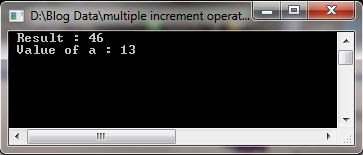I came across this problem while reading a program in my sophomore year. When multiple increment operators are used in a single statement, the results can be quite unpredictable. For e.g, consider this piece of code :
int C,a = 10;
C = a++ + ++a + ++a + a;
std::cout<<C<<" "<<a;
Now, usually the compiler evaluates the expression from right to left, and hence the result should come out to be 10 + 11 + 12 + 12 = 45(if my math is correct :p), but when the program is executed, the result comes out to be 12 + 12 + 12 + 12 = 48( :O ). Does this mean that the computer made a mistake ?? No, the compiler did not. What happened actually is that when multiple increment operators are used in a single statement, the compiler
1 - first evaluates all the prefix expressions i.e. ++a leading the value of 'a' to be 11 then again ++a, thus 'a' becomes 12.
2 - then the expression is evaluated, so the expression becomes 12 + 12 + 12 + 12 = 48;
3 - finally it evaluates the postfix expressions i.e a++ hence the the final value of 'a' becomes 13.
The following program demonstrates the above concept :// Multiple incremnet operators in a single expression
#include <iostream>
int main()
{
int a = 10,result;
result = a++ + ++a + ++a + a;
std::cout<<" Result : "<<result; // displays the result
std::cout<<" \n Value of a : "<<a; // displays the value of a
std::cin.get();
return 0;
} // end of main
 |
| Output in turbo compiler |
NOTE : The above output is obtained when the program is executed using a turbo C++ compiler or a borland c++ compiler.
The way in which the expression is evaluated varies from compiler to compiler. For e.g, when the same program is executed in Dev-C++, the result comes out to be 46. Hence different compilers evaluate an expression containing multiple increment operators differently.
------Related Posts ------
http://programsplusplus.blogspot.com/2012/01/4-pre-and-post-increment-operators.html
 |
| Output in dev-c++ |
------Related Posts ------
http://programsplusplus.blogspot.com/2012/01/4-pre-and-post-increment-operators.html
























